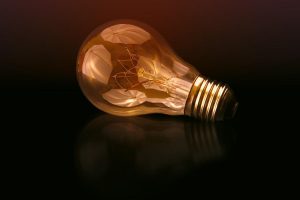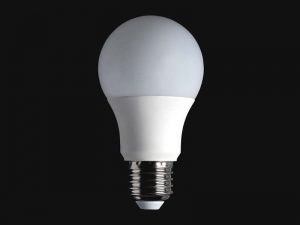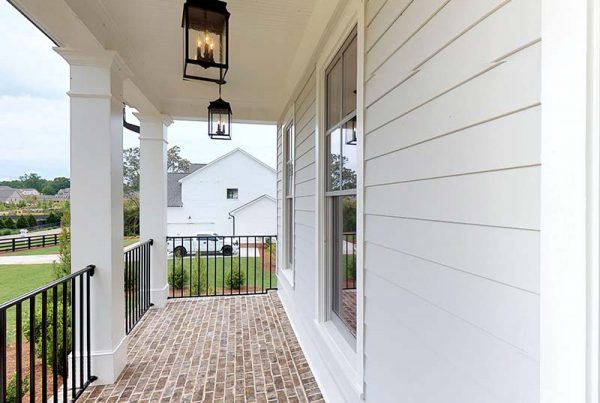Are you curious to know what is an LED light? And, are you wondering how we got to the point in history where we could inexpensively buy and maintain these innovative little LED lights in our homes and electronic devices?
Let’s dive into the history of light, the LED, the benefits of this new technology, and how you can tap into these savings.
 The History Of Electrically Powered Light
The History Of Electrically Powered Light
When it comes to lighting innovation, we’ve come a long way in the last decade — and past few centuries. Since 1879 a majority of home lighting was powered by the Thomas Edison bulb we know as the incandescent light — The precursor for fluorescent lights would be invented by Peter Cooper Hewitt at the turn of the 20th century. In 1908, the Edison lightbulb screw became universal and would dominate until 1951, when Fluorescents would overtake incandescent lights — primarily due to World War 2’s need for efficient lighting. Fluorescents would eventually go spiral (as we often know them now) in 1976 with the work of Edward Hammer at General Electric — the first CFL would hit the consumer market in 1985.
 The History of The LED — Light-Emitting-Diode
The History of The LED — Light-Emitting-Diode
The LED light revolution we all now a part of was started by Nick Holonyak Jr. in 1962. He created the first light-emitting-diode (LED’s meaning). In 1978, LED lights would begin to show up in consumer products, and in 1994 blue and white LED technology was discovered. In 2000, the energy department partnered with private companies to help move white LED technology forward and over the following eight years, starting in 2002, the first residential LED bulbs hit the market. In 2008, the energy department launched a competition to continue spurring the effort onward with the intention to replace common lighting technologies — the contest was won by Philips with its sixty-watt replacement LED bulb. In 2012, forty-nine million LED products were installed across the United States and in 2013, the prices dramatically began to drop leading to wide adoption, safety improvements, and energy savings for American homeowners.
The shift has been so dramatic that General Electric stopped making CFL bulbs and focused solely on the new and better, LED technology. This lighting is the future of home lighting and while certain applications will use other technologies (like the industrial realm) we are moving towards a world where LEDs will light 90% of the world during the“dark times” 😁.
 The Drastic Time And Financial Savings From Low Cost LED Lights
The Drastic Time And Financial Savings From Low Cost LED Lights
When you switch out a sixty-watt incandescent light bulb with a four-point-five watt LED bulb, the savings are going to be dramatic, especially switching all lightbulbs across your home. And, these powerful LED bulbs can go toe-to-toe in the amount of light (lumens) projected across a room. By moving to LED, you can expect 90% savings — using dramatically less electricity.
And, you’ll save an abundance of time not having to replace broken lightbulbs. At L&M Electric’s headquarters in Snellville, Georgia we have 140 recessed lights throughout our office. After moving in several years ago, we switched them all out with LED bulbs. Since then, we’ve had to replace six or seven bulbs. If we kept them as incandescence bulbs, we’d have changed all 140 five to ten times each, by now. Not only is the electricity savings terrific, but so is the time in keeping working bulbs installed. And if you tend to leave your lights on — or have kids who do — it’s time to make the transition in your home.
If you tie in smart home technologies like smart switches, you can take these savings even further. Learn more about this here or give us a call at 1-877-563-5328 to discuss your innovative technology options.
One last thing to note about the potential non-savings of using certain specialty LED lights. While the cost of normal LED lights has dropped drastically, there are still a number of specialty fixture lights that have unique shapes. While the energy use will be dramatically less than that of the alternatives, the cost of the specialty light bulb will likely supersede the cost of the bulb itself. Keep this in mind as you explore your options, and know even when you don’t save, you’re still benefiting from other LED advantages (see below).
 Away From Toxicity & Towards Earth Friendly
Away From Toxicity & Towards Earth Friendly
The adoption of LED bulbs is generating epic savings homeowners and organizations.
A major hospital in the Atlanta area spends millions of dollars safely discarding their mercury powered — and potentially dangerous — light bulbs.
Also, one of our electric specialists heard of a story where a woman was given a $40k bill for hazmat coming to her home to clean up broken CFL bulbs in their home. While the hazmat team likely went overboard in cleaning up the mercury, there is a legitimate health risk to many of the bulbs we’ve used in homes and businesses over the years (and why we recommend proper disposal if you have any of these mercury infused lights).
LED Light Quality Standards
Do the LED lightbulbs you’ve been purchasing have the energy star label? Not all LED lights are of high color quality, efficiency, or immediate as you might expect. It’s for this reason that the department of energy has set a standard for what LED light products should attain to meet the expectations of home-owning consumers around the country.
Energy Star Rated LED Products reduce energy costs, reduce maintenance costs, reduce cooling costs, are guaranteed, and are durable. They are also long-lasting — in addition to efficient — not losing their color over time. To receive the rating, an LED’s bulb must be equal to or greater than existing technology, constant over time (35,000 hours or 12 years), excellent color quality, more efficient than fluorescent lights, instant light when turned on (without flickering), and no use of power when not in use.
Other Benefits of LED Lights
- Durability: They don’t break easily, unlike those incandescent bulbs with a filament.
- Design Flexibility: Because of the LED construction, the bulbs can be shaped and formed for almost any application.
- Extreme Temperature Flexibility: Often we need lights when it’s extremely cold and hot. LED lights work great in these often unpredictable environments. While these may not be relevant to the home owner’s indoor lighting, it can make a difference in the outdoor and landscape lights.
- Instant Lighting: Unlike fluorescent and CFL bulbs, which can share some energy savings, LED bulbs are on full lumens from the instant you flip the switch.
- Low Voltage: LED bulbs are low voltage allowing for use in even small applications. It also makes their use safer.
Once you understand, it’s quite clear why LED has dominated the market and will soon take it over almost exclusively. It’s this place of adoption that fuels innovative uses of this technology.
LED Light Options — Color Variations, Dimmable, & Smart LED Bulbs
In addition to being a replacement for your existing lights, the LED has other variations to consider. Three of the more common include:
- LED Light Color Variations: Choose from a cool blue color or a warm yellowish tint when selecting your bulbs. If you prefer natural (sun-like) lighting, we recommend going with the warm LEDs. Some Smart bulbs also allow for changing the color on-demand, to a variety of colors.
- Dimmable LEDs: You can also purchase LED lights bulbs that dim like the light predecessors. Smart bulbs will allow you to do this from your phone as opposed to simply from the switch.
- Smart LED Lights: And finally, and quite popularly, LED light bulbs can now be found as Smart LEDs. This allows you to control your lighting through your device remotely using your wireless internet network. You can even create schedules and do a variety of fun and interesting things with them.
If you’re interested in transitioning your home to a Smart one, check out this page or give us a call at 1-877-563-5328.
 Dimming The Lights On This Blog Post
Dimming The Lights On This Blog Post
In this article, we’ve explained the history of lights and the LED, the many benefits you get from using them, and the options you have for leveraging this technology while also maintaining a positive impact on the world we live in.
If you want help making the switch to LED, upgrading your home to a smart house, or updating any electrical systems that are not currently compatible with LED lights, give us a call at 1-877-563-5328 or send us an email.








